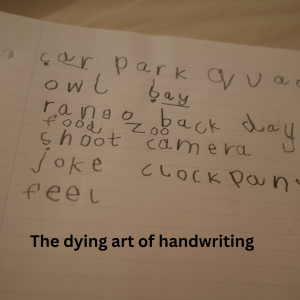Handwringing over handwriting
 Recent reports have shone a light on the declining standards of children’s handwriting and its increasing illegibility.
Recent reports have shone a light on the declining standards of children’s handwriting and its increasing illegibility.
We must assume that not all of them have careers as GPs lined up, but that there is a lack of focus on it in schools.
With the rise of technology including iPads and keyboards it is not perhaps a surprise that children do less handwriting now than they did previously.
But the impact of lockdowns on learning has meant a generation coming through the system who did not receive the guidance or practice they required.
Some will say that the declining standards is nothing to worry about because people are less likely to need the skills later in life due to all the tech, including voice recognition and predictive text.
I disagree. I believe handwriting is important for several reasons.
It is not the same as losing trigonometric tables because of the rise of calculators.
Handwriting is important because it connects hand-eye motor skills – a physical response to intellectual development in a different way to typing on a screen.
Furthermore, many will understand that writing notes long-hand is a great tool for revision because it helps the information to be absorbed.
And is important to learn the skill for letter writing, essay writing, filling out forms, writing notes and having a basic way to communicate with pen and paper.
Joined-up or cursive handwriting is an important and necessary skill for life and should be taught at primary level. It is very difficult to include it in the secondary curriculum because there simply isn’t time.
Handwriting is best taught in stages at primary level. There are six years to achieve this skill and it should be learned alongside reading skills.
It doesn’t matter how much technology we have, this skill must be maintained and it needs to be taught early.
It can be taught in the following way once children have learnt the letters of the alphabet in upper and lower case.
I always used four lines to teach a child to write letters neatly – on and between the lines. This begins with non-cursive writing.
_____________________
_____________________
_____________________
_____________________
Four lines gives three spaces – top, middle and bottom. The following examples should help.
‘a’ only uses a middle space
‘b’ uses middle and top
‘g’ uses middle and bottom
The same principle can be applied to the upper-case letters.
By using the four-line, three-space method it ensures that children with poorer motor skills learn to write neatly and cogently. Letters should be practised across the page and given for homework until every child is proficient in writing the letters using the lines.
The same technique can be utilised with cursive writing. I start children joining up two letters and then three etc until they can write the alphabet without taking their pen off the page. All this must be done in a structured manner.
Then the lines can be replaced with one line and children will write neatly without the supporting technique.
I have had to correct several children’s handwriting in secondary school because it was never sorted out at primary level. However, with the complexity of the secondary school curriculum there is little time to do this, and it can be a distraction from other learning that needs to take place. This is a primary curriculum matter.
I would also advocate that as soon as handwriting is properly mastered, children should be taught to touch type – not the one-finger or two-finger variety. I remember when I did my first degree I had to employ a typist to type my dissertation because I couldn’t do it.
This was before computers were widely used and Microsoft Word was not invented. However, when I did my first master’s degree I was determined to type the dissertation myself.
I had typing lessons and within a few weeks was touch typing. At the time a lot of people said I should just get by and dab away at the keys, but that was inefficient. I can now type as quickly as I can think.
This is what we should be aiming for in primary school. Every child should be able to write in legible, cursive handwriting – and be able to touch type.
ends